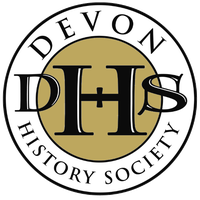Fursdon, Mrs Florence, Halsdon House, Honiton
Florence Rose Mary Fursdon née Trelawney[1] (1870 – 1941), was born on 16 Aug 1870 in Kensington, the only child of Sir William Lewis Salusbury Trelawney of Trelawney Manor, Duloe, Cornwall and his first wife, Jessy Rose Murray. Florence’s mother died in 1871 and Sir William married again in 1872. With his second wife, Harriet Buller Kitson, he had two boys and two girls, Florence’s half-siblings. Florence grew up partly at Trelawney Manor and partly at the family’s London home in Kensington.
When she was twenty Florence married Edward Fursdon, a member of the Devon Fursdon family, at a big society wedding held at Christ Church, Lancaster Gate, and featured in the Court Circular section of the London Evening Standard.[2]Edward was described as ‘of Peel Hall, Menheniot’, but that does not seem to have been a permanent home, although their daughter Harriet was born there in 1894. The Fursdons were living at Bellenden, Wreford’s Lane, Exeter in 1901 and at St Martin’s, Kingskerswell in 1911. Florence and Edward had three children in all, a boy and two girls.
‘Mrs Edward Fursdon’ is identified at a lunch given by the Exeter branch of the National Union of Women’s Suffrage Societies for the Earl of Lytton (Conciliation Committee Chair) in 1910[3]. In 1913, by this time living in Kingskerswell, she wrote to the Devon and Exeter Gazette (DEG) in 1913, in a letter also signed by T. Bell Fursdon, in which she drew attention to the inconsistencies in the Primrose League’s approach to women. On the one hand it was claimed that the women of the League were ‘awake to the nation’s dangers and anxious to work for the safety of the Empire’. On the other hand women were ‘not fit to be entrusted with legislative and imperial affairs’. She proposed women should abstain from taking part in politics at the coming General Election.[4] A reply from ‘John Bull’ led to another letter in which she pointed out how much MPS owed to women.[5]
By the end of 1913 the Fursdons had moved to Halsdon House near Honiton and, when the South West Federation of the National Union of Women’s Suffrage Societies determined to set up a Honiton branch Florence volunteered to become treasurer. She also attended the meeting held to launch the branch.[6] By January 1914 she appears to have succeeded Miss Kirton as branch secretary and, in that capacity, wrote to the papers giving details of the first public meeting of the branch at which Mrs Wyndham Bruce (q.v.) and Miss Walford were to speak.[7]
Fursdon also had a letter published in the Devon and Exeter Gazette, following the visit of Canon Masterman, in which she urged the formation of a branch of the Church League for Women’s Suffrage in Exeter, pointing out that the only one in Devon at that time was in Axminster.[8]
The outbreak of the First World War revealed Fursdon as ultra-patriotic. She raised concerns in The Common Cause about the unjustified plans to supervise soldiers’ dependents to whom allowances were being made.[9] In 1915 she expressed her hostility to what she perceived as the influence being wielded within the NUWSS by the Union of Democratic Control, a socialist and pacifist organisation, supported by distinguished suffrage activist Helena Swanwick, which aimed to pursue independent lines of foreign policy based on democratic principles. This organisation using ‘anti-British, pro-German, priest-fed propaganda’ she claimed to the DEG, had circularised the branches of the NUWSS, seeking their co-operation. To co-operate, Fursdon claimed, would be tantamount to ‘high treason’.[10] The DEG gave her article a two column spread. This prompted a published response and a further letter from Fursdon, again published at length, in which she claimed that ‘we are living in a hot-bed of treason and unrest’.[11] Fursdon had signed her article as ‘Honorary Secretary of the NUWSS’, appearing to give herself an authoritative place within the organisation. The Morning Post reprinted it; Helena Swanwick described it as a ‘wild article’, and Oliver Strachey, as an NUWSS council member, condemned its attempt at ‘spy-hunting.[12] This disagreement led to Fursdon’s withdrawal from further NUWSS work.
Fursdon published ‘The Story of Amanda’ (London, Simpkin, Marshal, Kent and Co) in 1914. The advertisement in The Common Cause promoted it as showing that ‘the feminist movement might be likened to the sea serpent which at rare intervals and unlikely places … rears its head for a moment and then disappears.’[13]
Fursdon and her daughter Grace were killed during the Second World War in September 1941 when the ship they were on, the SS Avoceta, was sunk by an enemy submarine on a crossing from the Azores to the UK. Their address at the time of their death was given as Moor View Lodge, Pennsylvania, Exeter.
Entry created by Julia Neville, October 2018
[1] Family and census information from www.ancestry.co.uk
[2] London Evening Standard, 18 Nov 1891/
[3] DEG, 8 Nov 1910.
[4] DEG, 20 Feb 1913.
[5] DEG, 26 Feb 1913.
[6] DEG, 5 Dec 1913.
[7] DEG, 27 Jan 1914; Miss Kirton later appears again as branch secretary (CC, 1 May 1914).
[8] DEG, 19 May 1914.
[9] CC, 4 Dec 1914.
[10] DEG, 18 Aug 1915.
[11] DEG, 23 Aug 1915.
[12] CC, 3 Sep 1915.
[13] CC, 8 May 1914.
